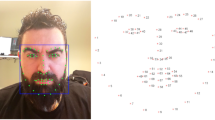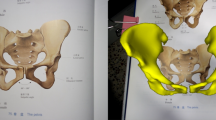Abstract
This paper presents a novel base-points-driven shape correspondence (BSC) approach to extract skeletons of articulated objects from 3D mesh shapes. The skeleton extraction based on BSC approach is more accurate than the traditional direct skeleton extraction methods. Since 3D shapes provide more geometric information, BSC offers the consistent information between the source shape and the target shapes. In this paper, we first extract the skeleton from a template shape such as the source shape automatically. Then, the skeletons of the target shapes of different poses are generated based on the correspondence relationship with source shape. The accuracy of the proposed method is demonstrated by presenting a comprehensive performance evaluation on multiple benchmark datasets. The results of the proposed approach can be applied to various applications such as skeleton-driven animation, shape segmentation and human motion analysis.












Similar content being viewed by others
References
Aflalo Y, Dubrovina A, Kimmel R (2013) Spectral generalized multi-dimensional scaling. arXiv preprint arXiv:13112187
Ahuja RK, Magnanti TL, Orlin JB (1993) Network flows: theory, algorithms, and applications
Anguelov D, Srinivasan P, Koller D, Thrun S, Rodgers J, Scape DJ (2005) Shape completion and animation of people. ACM Trans Graph 3:408–416
Au OK-C, Tai C-L, Chu H-K, Cohen-Or D, Lee T-Y (2008) Skeleton extraction by mesh contraction. ACM Trans Graph 3:44
Bandouch J, Engstler F, Beetz M (2008) Accurate human motion capture using an ergonomics-based anthropometric human model. In: Articulated motion and deformable objects. Springer 248–258
Bandouch J, Jenkins OC, Beetz M (2012) A self-training approach for visual tracking and recognition of complex human activity patterns. Int J Comput Vis 99(2):166–189
Baran I, Popović J (2007) Automatic rigging and animation of 3d characters. ACM Trans Graph 3:72
Berretti S, Werghi N, Del Bimbo A, Pala P (2013) Matching 3D face scans using interest points and local histogram descriptors. Comput Graph 37(5):509–525
Bronstein MM, Kokkinos I (2010) Scale-invariant heat kernel signatures for non-rigid shape recognition. IEEE Conf Comput Vis Pattern Recognit. IEEE 1704–1711
Chaaraoui AA, Climent-Pérez P, Flórez-Revuelta F (2013) Silhouette-based human action recognition using sequences of key poses. Pattern Recogn Lett 34(15):1799–1807. doi:10.1016/j.patrec.2013.01.021
Coifman RR, Lafon S (2006) Diffusion maps. Appl Comput Harmon Anal 21(1):5–30. doi:10.1016/j.acha.2006.04.006
Cornea ND, Demirci MF, Silver D, Shokoufandeh A, Dickinson SJ, Kantor PB (2005) 3D object retrieval using many-to-many matching of curve skeletons. In: Shape modeling and applications. Int Conf IEEE 366–371
Cornea ND, Silver D, Min P (2007) Curve-skeleton properties, applications, and algorithms. IEEE Trans Vis Comput Graph 13(3):530–548. doi:10.1109/TVCG.2007.1002
Deutscher J, Reid I (2005) Articulated body motion capture by stochastic search. Int J Comput Vis 61(2):185–205
Dey TK, Li K, Luo C, Ranjan P, Safa I, Wang Y (2010) Persistent heat signature for pose‐oblivious matching of incomplete models. Comput Graphics Forum 5:1545–1554, Wiley Online Library
Eldar Y, Lindenbaum M, Porat M, Zeevi YY (1997) The farthest point strategy for progressive image sampling. IEEE Trans Image Proc Publ IEEE Signal Proc Soc 6(9):1305–1315. doi:10.1109/83.623193
Golovinskiy A, Funkhouser T (2009) Consistent segmentation of 3D models. Comput Graph 33(3):262–269
Hahmann S, Belyaev A, Busé L, Elber G, Mourrain B, Rössl C (2008) Shape interrogation. In: Shape analysis and structuring. Springer 1–51
Jia T, Wang K, Wu Z, Zhao J, Xu P, Liu C, Zhou M (2014) Isometric shape matching based on the geodesic structure and minimum cost flow. In: Cyberworlds (CW), 2014 International Conference on. 122–129. doi:10.1109/CW.2014.25
Jiang W, Xu K, Cheng Z-Q, Martin RR, Dang G (2013) Curve skeleton extraction by coupled graph contraction and surface clustering. Graph Model 75(3):137–148
Kimmel R, Sethian JA (1998) Computing geodesic paths on manifolds. Proc Natl Acad Sci 95(15):8431–8435
Kin‐Chung Au O, Tai CL, Cohen‐Or D, Zheng Y, Fu H (2010) Electors voting for fast automatic shape correspondence. Comput Graphics Forum 2:645–654, Wiley Online Library
Kravtsov D, Fryazinov O, Adzhiev V, Pasko A, Comninos P (2014) Controlled metamorphosis between skeleton‐driven animated polyhedral meshes of arbitrary topologies. Comput Graphics Forum 1:64–72, Wiley Online Library
Lafon SS (2004) Diffusion maps and geometric harmonics. Ph.D. Dissertation, Yale University, May 2004
Le BH, Deng Z (2014) Robust and accurate skeletal rigging from mesh sequences. ACM Trans Graph 33(4):84
Li X, Woon TW, Tan TS, Huang Z Decomposing polygon meshes for interactive applications. In: Proceedings of the 2001 symposium on Interactive 3D graphics, 2001. ACM 35–42
Lian Z, Godil A, Bustos B, Daoudi M, Hermans J, Kawamura S, Kurita Y, Lavoué G, Van Nguyen H, Ohbuchi R (2011) SHREC’11 track: shape retrieval on non-rigid 3D watertight meshes. 3DOR 11:79–88
Ma J, Choi S (2014) Kinematic skeleton extraction from 3D articulated models. Comput Aided Des 46:221–226
Mahmoudi M, Sapiro G (2009) Three-dimensional point cloud recognition via distributions of geometric distances. Graph Model 71(1):22–31
Ovsjanikov M, Mérigot Q, Mémoli F, Guibas L (2010) One point isometric matching with the heat kernel. Comput Graphics Forum 29(5):1555–1564. doi:10.1111/j.1467-8659.2010.01764.x
Reuter M, Wolter F-E, Peinecke N (2006) Laplace–Beltrami spectra as ‘Shape-DNA’of surfaces and solids. Comput Aided Des 38(4):342–366
Sahillioğlu Y, Yemez Y (2010) 3d shape correspondence by isometry-driven greedy optimization. IEEE Conf Comput Vis Pattern Recognit. IEEE 453–458
Sahillioǧlu Y, Yemez Y (2011) Coarse-to-fine combinatorial matching for dense isometric shape correspondence. Comput Graphics Forum 30(5):1461–1470. doi:10.1111/j.1467-8659.2011.02020.x
Sahillioglu Y, Yemez Y (2012) Minimum-distortion isometric shape correspondence using EM algorithm. IEEE Trans Pattern Anal Mach Intell 34(11):2203–2215. doi:10.1109/TPAMI.2012.26
Sahillioğlu Y, Yemez Y (2014) Partial 3-D correspondence from shape extremities. Comput Graphics Forum 33(6):63–76. doi:10.1111/cgf.12278
Schwarz LA, Mkhitaryan A, Mateus D, Navab N (2012) Human skeleton tracking from depth data using geodesic distances and optical flow. Image Vis Comput 30(3):217–226. doi:10.1016/j.imavis.2011.12.001
Shapira L, Shamir A, Cohen-Or D (2008) Consistent mesh partitioning and skeletonisation using the shape diameter function. Vis Comput 24(4):249–259. doi:10.1007/s00371-007-0197-5
Smeets D, Hermans J, Vandermeulen D, Suetens P (2012) Isometric deformation invariant 3D shape recognition. Pattern Recog 45(7):2817–2831. doi:10.1016/j.patcog.2012.01.020
Sun J, Ovsjanikov M, Guibas LA (2009) Concise and provably informative multi‐scale signature based on heat diffusion. Comput Graphics Forum 5:1383–1392, Wiley Online Library
Tagliasacchi A, Zhang H, Cohen-Or D (2009) Curve skeleton extraction from incomplete point cloud. ACM Trans Graph 3:71
Tam GK, Cheng ZQ, Lai YK, Langbein FC, Liu Y, Marshall D, Martin RR, Sun XF, Rosin PL (2013) Registration of 3D point clouds and meshes: a survey from rigid to nonrigid. IEEE Trans Vis Comput Graph 19(7):1199–1217. doi:10.1109/TVCG.2012.310
Vlasic D, Baran I, Matusik W, Popović J (2008) Articulated mesh animation from multi-view silhouettes. ACM Trans Graph 27(3):97
Wang K, Wu Z, Xu P, Zhao J, Jia T, Shui W, Ali S, Zhou M (2014) Scale-invariant heat kernel mapping. Cyberworlds, Int Conf 114–121. doi:10.1109/CW.2014.24
Wong S-K, Yang J-A, Ho T-C, Chen Y-C, Chuang J-H (2012) A skeleton-based approach for shape correspondence. Paper presented at the Proceedings of the 11th ACM SIGGRAPH International Conference on Virtual-Reality Continuum and its Applications in Industry, Singapore, Singapore
Yan HB, Hu SM, Martin RR, Yang YL (2008) Shape deformation using a skeleton to drive simplex transformations. IEEE Trans Vis Comput Graph 14(3):693–706. doi:10.1109/Tvcg.2008.28
Yang Y, Günther D, Wuhrer S, Brunton A, Ivrissimtzis I, Seidel H-P, Weinkauf T (2012) Correspondences of persistent feature points on near-isometric surfaces. In: Computer Vision–ECCV 2012. Workshops and Demonstrations. Springer 102–112
Yianilos PN (1993) Data structures and algorithms for nearest neighbor search in general metric spaces. Paper presented at the Proceedings of the fourth annual ACM-SIAM Symposium on Discrete algorithms, Austin, Texas, USA
Zhang MQ, Li F, Wang XC, Wu ZK, Xin SQ, Lui LM, Shi L, Wang DF, He Y (2014) Automatic registration of vestibular systems with exact landmark correspondence. Graph Model 76:532–541. doi:10.1016/j.gmod.2014.04.010
Zhang W, Shang L, Chan AB (2014) A robust likelihood function for 3D human pose tracking
Zhang H, Sheffer A, Cohen-or D, Zhou Q, Kaick OV, Tagliasacchi A (2008) Deformation-driven shape correspondence. Comput Graphics Forum 27(5):1431–1439. doi:10.1111/j.1467-8659.2008.01283.x
Zheng Q, Sharf A, Tagliasacchi A, Chen B, Zhang H, Sheffer A, Cohen-Or D (2010) Consensus skeleton for Non-rigid space-time registration. Comput Graphics Forum 29(2):635–644. doi:10.1111/j.1467-8659.2009.01633.x
Acknowledgments
The research is partially supported by National Natural Science Foundation of China (No.61170170 and 61170203) and the National Key Technology Research and Development Program of China (2012BAH33F04).
Author information
Authors and Affiliations
Corresponding author
Rights and permissions
About this article
Cite this article
Wang, K., Razzaq, A., Wu, Z. et al. Novel correspondence-based approach for consistent human skeleton extraction. Multimed Tools Appl 75, 11741–11762 (2016). https://doi.org/10.1007/s11042-015-2629-y
Received:
Revised:
Accepted:
Published:
Issue Date:
DOI: https://doi.org/10.1007/s11042-015-2629-y




